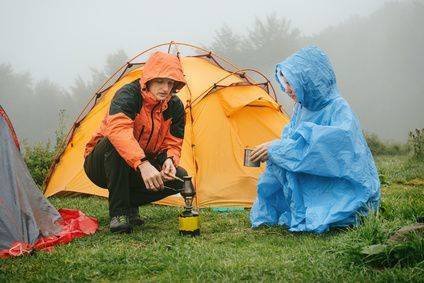Winter camping is a unique and invigorating experience – and your furry friend can make a wonderful camping partner. However, before heading out into the Great Outdoors, make sure you and your pooch are properly prepared.
Here are the top tips for winter camping with a dog!

How Cold is Too Cold to Camp with a Dog?
As a general rule, most dogs have no issues in temperatures above 45°F. If the temperature drops, dogs who don’t like the cold will likely show signs of discomfort and an eagerness to go inside. Unless the dog is a specific breed well-suited for cold weather, they shouldn’t spend any significant time outdoors when the temperature is below 45°.
When temperatures fall below freezing, you’ll need to take additional precautions to keep your dog safe. Never leave them unsupervised outside if the temperature is 32°F or lower.
However, these are only guidelines for dog camping in cold weather. Don’t rely on the number on the thermostat alone. Instead, watch your dog carefully for any signs of a negative reaction to the outdoor temperature.
Factors that Influence Your Dog’s Reaction to the Cold
Much like people, dogs have individual opinions about cold weather. For example, some dogs love to run and romp in the snow, while others prefer to spend their time indoors by a roaring fire. However, a few factors often play an important role in how your dog feels about the cold.
Size and Weight
Small dogs have more surface area to lose heat, so they often get cold quicker, and feel cold more severely, than larger breeds. Miniature and toy breeds in particular often dislike spending any time in cold weather.
Additionally, large breeds stay warmer because they have more body fat to use as insulation. Note this only applies to a dog’s natural, healthy weight. Never overfeed your dog during the winter months to fatten him up. The negative effects on your dog’s health far outweigh any increased cold resistance.
Coat Type and Color
Dogs with thick, fluffy coats feel warmer and more comfortable in the cold. Some examples include the Siberian Husky, bred to work on the tundra, and the American Eskimo Dog, with a lion-like mane and a coat rich with natural oils.
Coat color can also help keep your dog warm. Darker colors absorb and retain the heat from the sun. Dogs with black and brown coats typically stay more comfortable in cold weather, especially when the sun’s shining.
Age and Health
A dog’s sensitivity to cold typically increases if they have any of the following characteristics:
- They’re young (under a year)
- They’re old (around eight to 10, depending on the breed)
- They have health problems
Dogs with arthritis often have an especially hard time dealing with cold weather. Like with people, cold weather can increase joint stiffness and decrease muscle mobility in dogs. While you can take an arthritic dog camping in cold weather, you’ll need to take extra precautions to keep him warm and comfortable.
Cold Weather Camping Gear
Proper preparation protects your pets. You’ll need to bring along the following gear.
Coat
It should fit snugly but not tight. You should be able to slide two fingers between the coat and the dog’s body.
Also, choose a coat made from waterproof material. Otherwise, snow and rain accumulation can soak the coat and make it cold.
Bed
Your dog needs a warm, soft bed. It should have a thick base to protect your dog from the cold tent floor. The best bed will have a covering, which creates a type of tent that helps trap your dog’s body heat.
Another option is a bed with a separate blanket. Although it provides some warmth, it’s typically not as effective as a bed with a built-in top. As the dog shifts positions while sleeping, it can move the blankets out of place, exposing its body to cold air.
Booties
Booties help protect your dog’s feet in two ways. They help keep the bottom of the foot dry. Also, they help prevent ice from becoming packed between the dog’s toes.
Dogs can have varied, and sometimes strong, opinions on shoes. Some will tolerate them without an issue, but others will gnaw at them, refuse to walk, or otherwise not want anything to do with them. It is a good idea to test them out with your dog before going camping.
Heated Water Dish
You’ll also need a heated water dish. Dogs can’t stay hydrated by licking ice; they need access to fresh water at all times.
Although the majority of heated water dishes require access to an electrical outlet, you can still find a wide variety of battery or solar-powered options, which are far easier to use when dog camping.
Extra Food
Dogs who spend time in cold weather burn extra calories to stay warm. You’ll need to increase your daily diet by 10 to 15 percent. However, don’t overdo it. The extra calories should lead to little if any, weight gain.
Signs Your Dog is Cold
As mentioned above, while degrees matter, the best way to protect your pup is to keep a close eye on them when outside. Watch for the following signs:
- Shivering and excessive shaking
- Cold ears (even if the dog’s body is warm)
- Sluggish or limited movement
- Limping or frequent paw lifting
- Lack of energy or unusual sleepiness
At the first display of any of these symptoms, take your dog somewhere warm. Also, check their paws and remove any ice packed between their toes.
Final Thoughts
Dog camping in the winter can be a fun experience for both you and your canine companion. However, winter weather does pose certain risks, so make sure you watch your dog closely, pack all the appropriate gear described above, and never let your dog spend time outside unsupervised.
As long as you understand how to keep your dog warm during camping, the two of you can enjoy wonderful adventures together all winter long!





